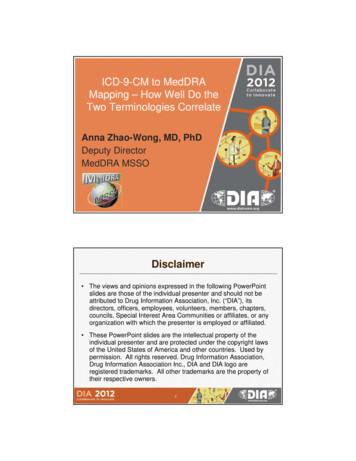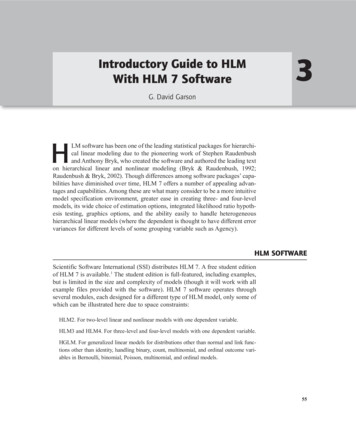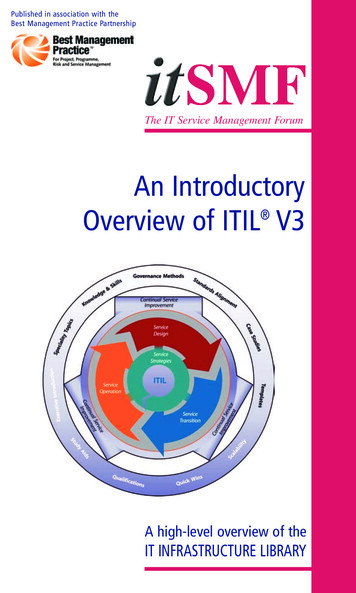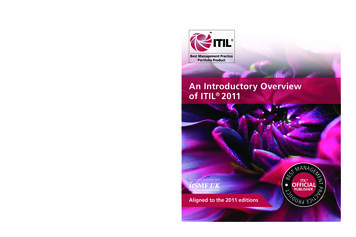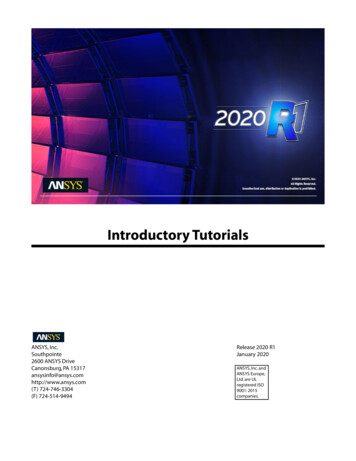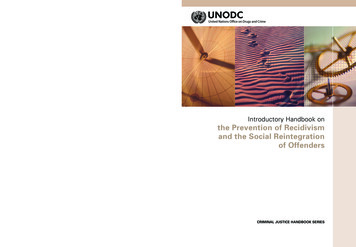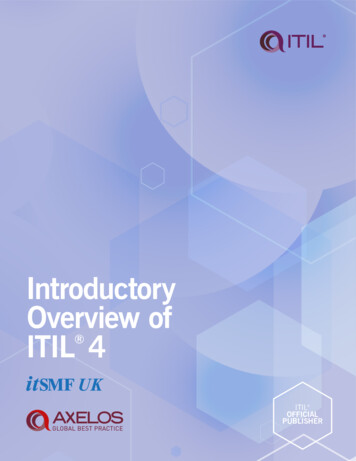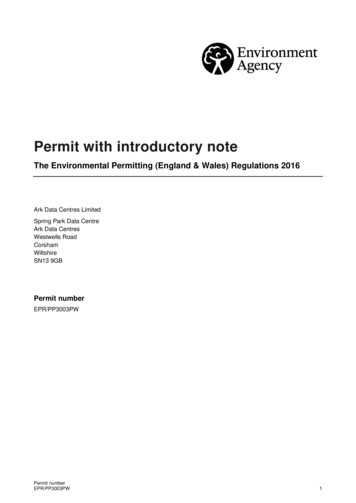
Transcription
Introductory GuideMedDRA Version 23.0March 2020000417
Notice to ReaderNotice to ReaderThis Introductory Guide is written in English and is intended only for use with theEnglish version of MedDRA. Additional Introductory Guides have been developed tosupport languages other than English and are included with their specific translationcopies.The Introductory Guide is intended for use in conjunction with the MedDRA Browsers,available with each MedDRA subscription.Changes which are version specific or changes in documentation may be found in theWhat's New document. This document is included with the MedDRA release and isalso posted on the MSSO Web site under Support Documentation.The MedDRA terminology is maintained under an ISO 9001:2015 registered qualitymanagement system.***In MedDRA Version 23.0, several complex changes worthy of note were implemented inSOC Congenital, familial and genetic disorders to refine the hierarchical placement ofgenetic term concepts. Descriptions of the following modifications have beenincorporated into the text of Section 6.3.1 of this document: HLGT Chromosomal abnormalities and abnormal gene carriers was replacedwith new HLGT Chromosomal abnormalities, gene alterations and gene variantsto represent that SOC Congenital, familial and genetic disorders is intended tocover gene concepts, whether they are acquired or congenital. HLT Gene mutations and other alterations NEC was added to new HLGTChromosomal abnormalities, gene alterations and gene variants, and former HLTAcquired gene mutations and other alterations was merged into the new HLTGene mutations and other alterations NEC. This new HLT groups together allgene conditions and alterations such as overexpressions, rearrangements, andmutations, regardless of whether they are congenital or acquired, and separatesgene concepts from chromosomal concepts which are represented in other HLTsof SOC Congenital, familial and genetic disorders. New HLT Genetic polymorphisms was added to HLGT Chromosomalabnormalities, gene alterations and gene variants. The creation of an HLT forgenetic polymorphisms, which are considered as gene variants rather than genealterations, aids in the coding and retrieval of these concepts.Existing Preferred Terms were moved or realigned as appropriate in accordance withthe revised hierarchical groupings in SOC Congenital, familial and genetic disorders.MedDRA Introductory Guide Version 23.0March 2020000417ii
AcknowledgementsAcknowledgementsMedDRA trademark is registered by ICH.The following sources of information are also acknowledged: Diagnostic and StatisticalManual of Mental Disorders, Fifth Edition (DSM-5) Copyright 2013 AmericanPsychiatric Association. ICD-9-CM, International Classification of Diseases, NinthRevision, Clinical Modification, Copyright 1998 Medicode, Inc. COSTART ThesaurusFifth Edition, Copyright 1995 US Food and Drug Administration (FDA). HoechstAdverse Reaction Terminology System (HARTS), Copyright 1992 Aventis Pharma.WHO Adverse Reaction Terminology (WHO-ART), Copyright 1998 World HealthOrganization Collaborating Centre for International Drug Monitoring. Japanese AdverseReaction Terminology (J-ART) is a product of the Ministry of Health, Labour andWelfare (MHLW). LOINC is a registered trademark of Regenstrief Institute, Inc.Lanoxin is a registered trademark of GlaxoSmithKline. Merriam-Webster is aregistered trademark of Merriam-Webster, Incorporated. Merriam-Webster OnlineDictionary copyright 2005 by Merriam-Webster, Incorporated. Dorland's IllustratedMedical Dictionary, copyright 2004, W. B. Saunders, an Elsevier imprint.Disclaimer and Copyright NoticeThis document is protected by copyright and may, with the exception of the MedDRAand ICH logos, be used, reproduced, incorporated into other works, adapted, modified,translated or distributed under a public license provided that ICH's copyright in thedocument is acknowledged at all times. In case of any adaption, modification ortranslation of the document, reasonable steps must be taken to clearly label, demarcateor otherwise identify that changes were made to or based on the original document. Anyimpression that the adaption, modification or translation of the original document isendorsed or sponsored by the ICH must be avoided.The document is provided "as is" without warranty of any kind. In no event shall the ICHor the authors of the original document be liable for any claim, damages or other liabilityarising from the use of the document.The above-mentioned permissions do not apply to content supplied by third parties.Therefore, for documents where the copyright vests in a third party, permission forreproduction must be obtained from this copyright holder.MedDRA Introductory Guide Version 23.0March 2020000417iii
Table of ContentsTABLE OF CONTENTS1.2.3.4.INTRODUCTION . 71.1BACKGROUND . 71.2ADOPTION OF MEDICAL TERMINOLOGY AS AN ICH TOPIC . 81.3DEVELOPMENT OF THE MEDICAL DICTIONARY FORREGULATORY ACTIVITIES (MedDRA) TERMINOLOGY . 81.4IMPLEMENTATION OF THE TERMINOLOGY . 81.5SCOPE OF THE TERMINOLOGY . 91.6INCLUSION OF TERMS FROM ESTABLISHEDTERMINOLOGIES . 101.7EXCLUSION CRITERIA . 10STRUCTURAL ELEMENTS OF THE TERMINOLOGY . 112.1EQUIVALENCE . 112.2HIERARCHICAL . 11LEVELS OF STRUCTURAL HIERARCHY . 133.1LOWEST LEVEL TERMS . 133.2PREFERRED TERMS . 143.3HIGH LEVEL TERMS . 143.4HIGH LEVEL GROUP TERMS . 153.5SYSTEM ORGAN CLASS . 153.6STANDARDISED MedDRA QUERY (SMQ). 19RULES AND CONVENTIONS ADOPTED IN THE TERMINOLOGY(INCLUDING PRESENTATION AND FORMATTING OF TERMS) . 204.1SPELLING . 204.2ABBREVIATIONS . 204.3CAPITALIZATION . 214.4PUNCTUATION . 214.5SINGLE WORD VS. MULTIPLE WORD TERMS . 214.6WORD ORDER . 224.7MedDRA CODES . 224.8BODY SITE CONSIDERATIONS IN MedDRA . 224.9NUMERICAL VALUES . 23MedDRA Introductory Guide Version 23.0March 2020000417iv
Table of Contents5.6.4.10AGGRAVATION OF UNDERLYING CONDITIONS . 234.11NOS AND NEC TERMS . 234.12GENDER SPECIFIC TERMS . 244.13HIERARCHY NAMING CONVENTIONS . 24PT AND LLT NAMING CONVENTIONS . 265.1GENERAL WORD USAGE . 265.2GENERAL SEARCH STRATEGIES. 29SYSTEM ORGAN CLASSES. 306.1BLOOD AND LYMPHATIC SYSTEM DISORDERS. 316.2CARDIAC DISORDERS . 326.3CONGENITAL, FAMILIAL AND GENETIC DISORDERS . 336.4EAR AND LABYRINTH DISORDERS . 356.5ENDOCRINE DISORDERS . 366.6EYE DISORDERS. 376.7GASTROINTESTINAL DISORDERS . 396.8GENERAL DISORDERS AND ADMINISTRATION SITECONDITIONS. 406.9HEPATOBILIARY DISORDERS. 426.10IMMUNE SYSTEM DISORDERS. 436.11INFECTIONS AND INFESTATIONS . 456.12INJURY, POISONING AND PROCEDURAL COMPLICATIONS . 476.13INVESTIGATIONS . 506.14METABOLISM AND NUTRITION DISORDERS. 556.15MUSCULOSKELETAL AND CONNECTIVE TISSUEDISORDERS . 566.16NEOPLASMS BENIGN, MALIGNANT AND UNSPECIFIED (INCLCYSTS AND POLYPS) . 576.17NERVOUS SYSTEM DISORDERS . 596.18PREGNANCY, PUERPERIUM AND PERINATAL CONDITIONS 606.19PRODUCT ISSUES . 626.20PSYCHIATRIC DISORDERS. 646.21RENAL AND URINARY DISORDERS . 66MedDRA Introductory Guide Version 23.0March 2020000417v
Table of Contents6.22REPRODUCTIVE SYSTEM AND BREAST DISORDERS . 676.23RESPIRATORY, THORACIC AND MEDIASTINAL DISORDERS 686.24SKIN AND SUBCUTANEOUS TISSUE DISORDERS . 706.25SOCIAL CIRCUMSTANCES . 716.26SURGICAL AND MEDICAL PROCEDURES . 736.27VASCULAR DISORDERS . 75APPENDIX A: ACRONYMS . 76APPENDIX B: MedDRA CONCEPT DESCRIPTIONS . 79LIST OF TABLESTable 3-1. The MedDRA Terminology SOC List – Alphabetical Listing . 18Table 3-2. The MedDRA Terminology SOC List – Internationally AgreedOrder . 19Table 6-1. Sample of Exceptions and Conventions in SOC Immune SystemDisorders . 43LIST OF FIGURESFigure 2-1. Structural Hierarchy of the MedDRA Terminology . 12MedDRA Introductory Guide Version 23.0March 2020000417vi
Structural Elements of the Terminology1. INTRODUCTIONThe Medical Dictionary for Regulatory Activities (MedDRA) Terminology is theinternational medical terminology developed under the auspices of the InternationalCouncil for Harmonisation of Technical Requirements for Pharmaceuticals for HumanUse (ICH). This guide describes the development, scope, and structure of theterminology.1.1BACKGROUNDPrior to the development of MedDRA, there had been no internationally acceptedmedical terminology for biopharmaceutical regulatory purposes. Most organizationsprocessing regulatory data used one of the international adverse drug reactionterminologies in combination with morbidity terminology. In Europe, most of theseorganizations used a combination of the World Health Organization's Adverse ReactionTerminology (WHO-ART ) and the International Classification of Diseases NinthRevision (ICD-9). In the United States, the Food and Drug Administration's (FDA)Coding Symbols for a Thesaurus of Adverse Reaction Terms (COSTART ) was usuallyused in conjunction with Clinical Modification of ICD-9 (ICD-9-CM ). The Japanesedeveloped their own versions of these international terminologies, Japanese AdverseReaction Terminology (J-ART) and Medical Information System (Japan) (MEDIS). Inaddition, many organizations modified these terminologies to suit their needs.Established terminologies lacked specificity of terms at the data entry level, providedlimited data retrieval options (e.g., too few levels in the hierarchy, or capacity to retrievedata via one axis only), and did not handle syndromes effectively. Organizations withsufficient resources developed their own “in-house” terminologies to address some or allof these deficiencies.The use of multiple terminologies raised several problems. Using differentterminologies at various stages in a product's life complicates data retrieval andanalysis, making it difficult to cross-reference data. For example, safety data hadfrequently been classified for pre-registration clinical trials using ICD terminology and forpost-marketing surveillance using J-ART, WHO-ART, or COSTART. Furthermore,using different terminologies in separate geographic regions impaired internationalcommunication and necessitated the conversion of data from one terminology toanother. This data conversion had the potential to cause time delays and loss ordistortion of data. In particular, these problems affected multinational pharmaceuticalcompanies whose subsidiaries used multiple terminologies to fulfill the different datasubmission requirements of regulators. The use of multiple terminologies also affectedcommunication between companies and clinical research organizations.It became increasingly difficult to manage the information required for productregistration applications and to meet the time scal
Coding Symbols for a Thesaurus of Adverse Reaction Terms (COSTART ) was usually used in conjunction with Clinical Modification of ICD-9 (ICD-9-CM ). The Japanese developed their own versions of these international terminologies, Japanese Adverse Reaction Terminology (J-ART) and Medical Information System (Japan) (MEDIS). In addition, many organizations modified these terminologies to
